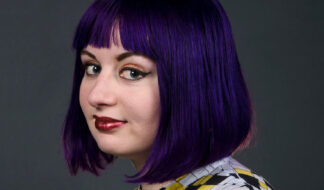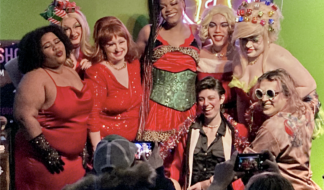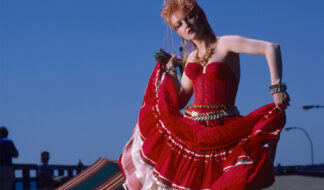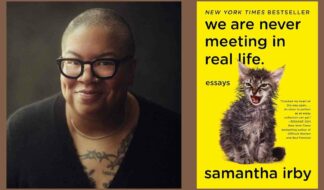How Machine Dazzle Is Transforming Our Collective Michigan Garbage Into Queer Joy
His first Midwest exhibition in Ann Arbor doesn’t just turn trash into treasure — it examines who we are and what we can become

The dildo sitting upright on the tabletop next to me looks like if it attacked me, I wouldn’t stand a chance. I don’t necessarily feel like I have to keep an eye on it, but I also can’t help it — it’s just that big. Later, when it’s not looking me in the eye, it appears smaller and less aggressive, even artfully elegant; that’s because this time, that phallus is inside a giant coiled vessel hanging from the ceiling of the evolving installation, in its first phase of three, at the Irving Stenn Jr. Family Gallery inside the University of Michigan Museum of Art (UMMA) — a university museum, bless them, is the home to this dildo.
But when I initially come face to head with it, it’s still in Machine Dazzle’s modest-sized studio, just casually hanging out. It’s the end of February when I meet with the New York-based artist internationally lauded for his special ability to maximize his resources for conceptual purposes, turning the most random objects into stunningly wearable sculptures — “more is more,” he told Artnet News in 2020.
As he sits in his studio among an assortment of everyday household items he’s picked out of trash recovered from the Huron River and waste management facilities in Michigan, it’s impossible to imagine how plastic Tide detergent containers and all these multi-colored dildos, many printed on a 3D printer at U-M, will be incorporated into his ambitious project, titled “Ouroboros,” described in press materials as “a maximalist wonderland inspired by the ancient symbol of a snake consuming its own tail.”
“What do you think that black thing is?” Machine says to me in his studio in February, pointing to something other than the dildo. He’s motioning to the opposite side of the room, where I try but fail to identify the distorted and reshaped black plastic — once flimsy flower pots, he tells me. Some of this trash Machine has handpicked straight from local bodies of water and recycling and garbage bins; some of it has come from dorms and residences on this very campus. “At the end of the day, it doesn’t really matter,” he says. “It came from fossil fuels.”
The plastic pieces on the floor, walls and tables in his studio haven’t coalesced just yet except inside the expansive universe of Machine’s mind, where there really seems to be no such thing as “less.” It’s anyone’s guess at this point exactly how he will work all of this stuff into his first major museum commission and debut exhibition in the Midwest, a project that began with site visits in October 2022 and made its museum debut in March.
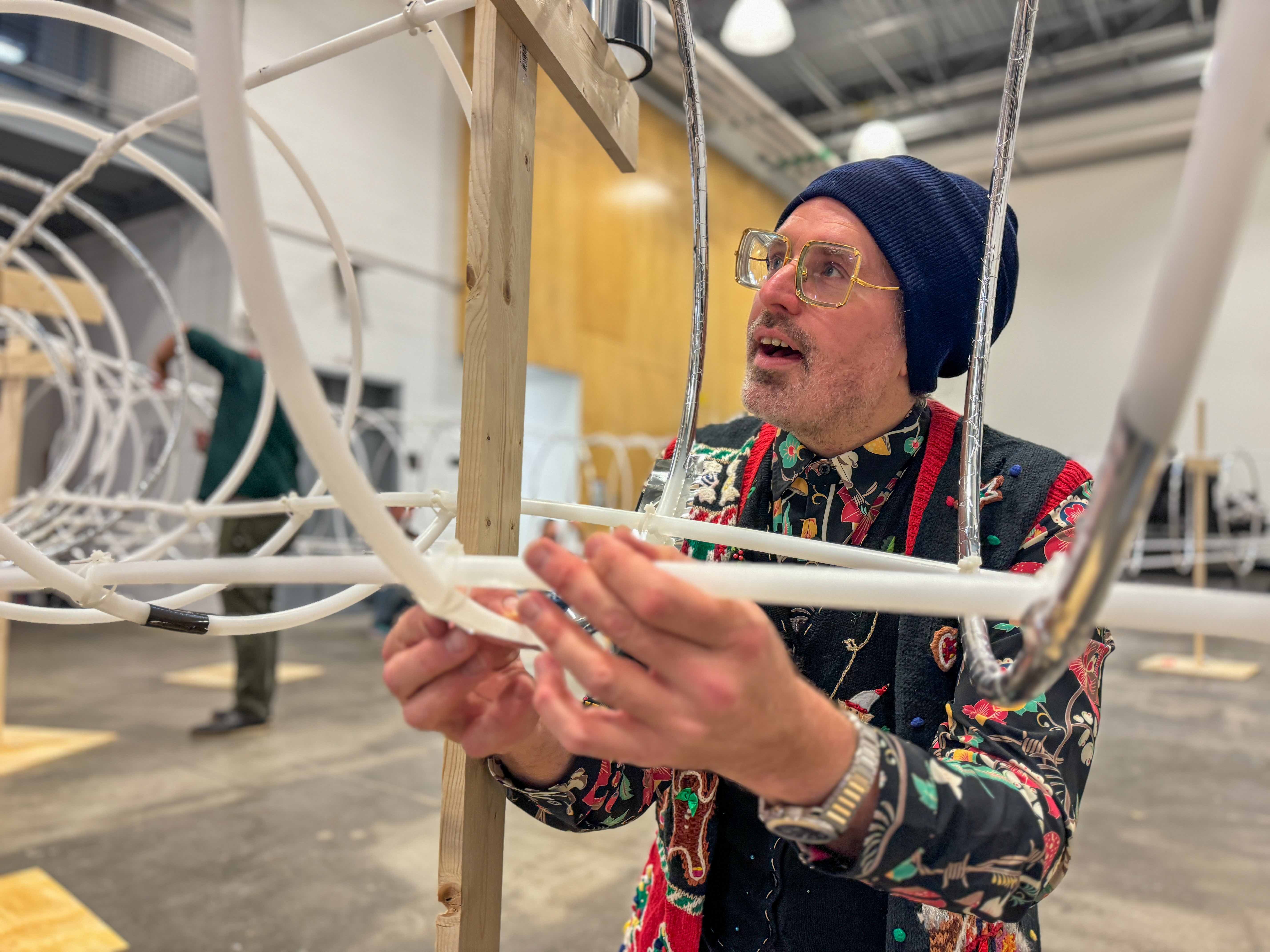
Like us, Ouroboros was always intended to change and grow over time, through three phases, the last occurring during Pride Month in June. So, how exactly will all of this be assembled into something meaningful when more trash and phalluses enter the vessel?
Calling it a “symbolic odyssey,” the museum answers this question over the course of six months, through Aug. 25, the last day to see Ouroboros up close and personal. On the day of our interview, just a couple of weeks before the initial installation, Machine is, of course, making very specific considerations as to how he sees it coming together. He shares his surprisingly relatable vision with me before the big base structure even enters the 1,200-square-foot Irving Stenn space, explaining how Ouroboros, if you’re looking at it with a degree of existential dread, which he can’t help but do given our sit-down is on the day of the presidential primaries when conservative-wielded queerphobia continues to run rampant, is really a physical representation of a renewal process that reshapes some kind of current state. What a coffee container can be. What a Kirkland olive oil bottle might be morphed into. What our country could become. And the part we play in all of this — “the past, present and future of waste,” he says.
“I mean, this is plastic,” he continues. “And so if you are a human and you’re alive, you’re participating in this never-ending cycle; it’s inevitable. I was just inspired by the objects. I started melting them or cutting them up or doing something, transforming them. And so this is kind of what I had interest in achieving. Once it’s in the sculpture, it’s like I have to make all of the objects and then I have to put them all together. It’s a whole process.”
The past is the plastic and the present is Ouroboros itself; the future is also Ouroboros as well as the 3D technology that Machine uses to print dildos or various containers, like one for antifreeze, that will enter the vessel. “We’re still in a very rough digital age,” he says. “This is kind of like the Atari or Coleco of what will happen in 20 years. Things are going to be so lifelike, you’re not going to be able to tell the difference. Even though we’re doing this now, it’s almost like I’m considering it like the future. And I really wanted to make it obviously sexual as if the garbage is reproducing itself, which is kind of what it’s doing already.”
If you think of the trash as humankind, which Machine does (“The garbage is us,” he says), then you could think of Ouroboros as a pioneering pursuit that broadens horizons to the uncharted realms of possibility. “Humankind is forever changing the earth’s surface and everything about it: the air, the water, the soil, our bodies; it’s just a never-ending cycle.” At 51, Machine has gone through enough of his own life cycles to be at least somewhat pessimistic about the future — these possibilities could get ugly — but he also isn’t going to stop people from turning their own trash, what they can control, into treasure. Including himself. Ouroboros, after all, is his version of changing what he can.
“We are never going to be on the same page,” he says. “I’m just being realistic. We can dream and we can hope. Fine. It’s not exactly a waste of time because if that makes you feel better, good. But when you think about it, if people aren’t all on the same page, we’re never going to work together, and problems are just going to get worse. Things are not going to get better. They’re going to get worse.”
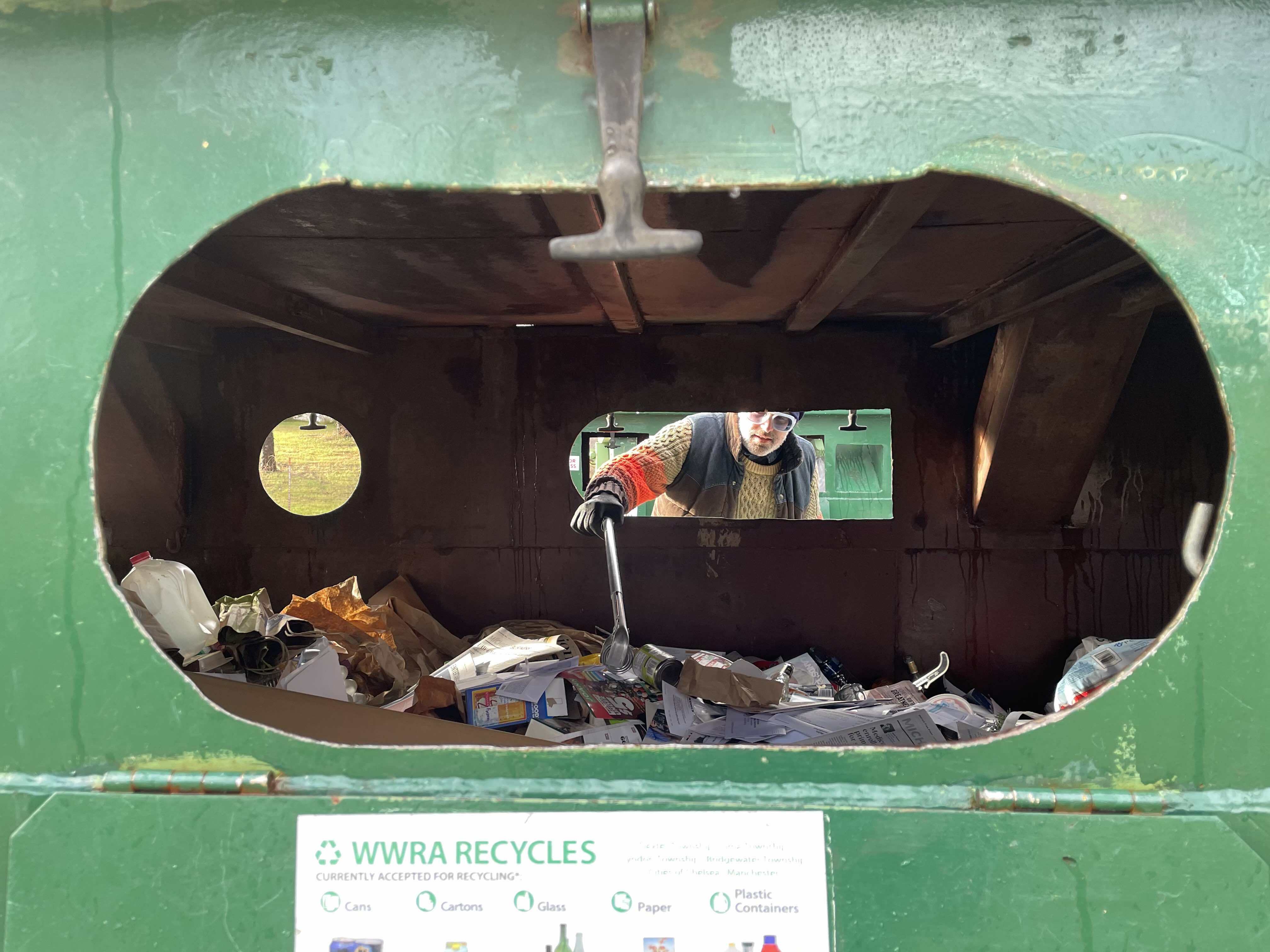
Existential dread aside, it also just boils down to Machine’s prolonged need for escapism: “I love transforming objects into things,” he says. As a kid, Machine transformed his own dislike for other young people into self-produced isolation. Born Matthew Flower in 1972 in rural Pennsylvania, he transformed his name too, at least for the stage. Before moving to New York City in the late 1990s and joining the group The Dazzle Dancers as a drag performer and costume designer, he always had a fascination for objects, going all the way back to his formative years growing up in Texas. At 6, he felt “not like the other boys,” and preferred looking for rocks and leaves by himself versus engaging with his peers. Teachers encouraged him to play with other students, “but they would annoy the fuck out of me,” Machine says.
“I grew up in pretty conservative places, and my parents were fairly conservative and from a very small town, and they didn’t know what to do with me,” he recalls. “They were dealing with their own homophobia. But they knew. My father admitted to me after my mother died, ‘I knew you were gay since you were 2 years old.’ But I think he was probably afraid to encourage it based on maybe his own homophobia, just not wanting to deal with what.”
Possibilities began to emerge for Machine on family visits to a whole generation’s ultimate hangout: the mall. Growing up, there wasn’t a community of TikTok creators to help him on his path to self-discovery. No computers, even. And definitely no cell phones.
“Here we are at JCPenney, here we are at Sears, and I was aware of fashion,” he says. “I had instincts that I couldn’t act on because we didn’t have the money, and my parents were not comfortable buying certain things for me. Of course, I was going to school with kids where their parents were doing that for them. And I would always just be like, ‘Wow, that’s what I want to do. I want to do my hair like that, or I would love to wear that.’”
Weeks after Machine tells me about his suppressed past, I’m watching him, someone who finally did do his hair “like that” (and then some), onstage during the opening day of Ouroboros, as he speaks at the Michigan Theater for his Penny Stamps Speaker Series talk. In delightful socks that feature the Whoppers candy logo, a glittery headdress resembling that of a Vegas showgirl and a silver-painted dress made from a tarp (he’s downright gleeful about the trip to Michaels he took to complete his look), his manifestation of self is as spectacularly alive and defiant as what I see during the unveiling of the installation inside the Irving Stenn Jr. Family Gallery just hours later.
“I definitely have a lot of suppressed anger,” he tells me in his studio, without needing to justify it — just look around at the current state of the world. “And what I’m trying to do is transform it into queer joy. That manifests in costume, music and sculpture. I’m turning it into something else because there’s nothing I can really do about it. I can vote. But I’m only one person.”
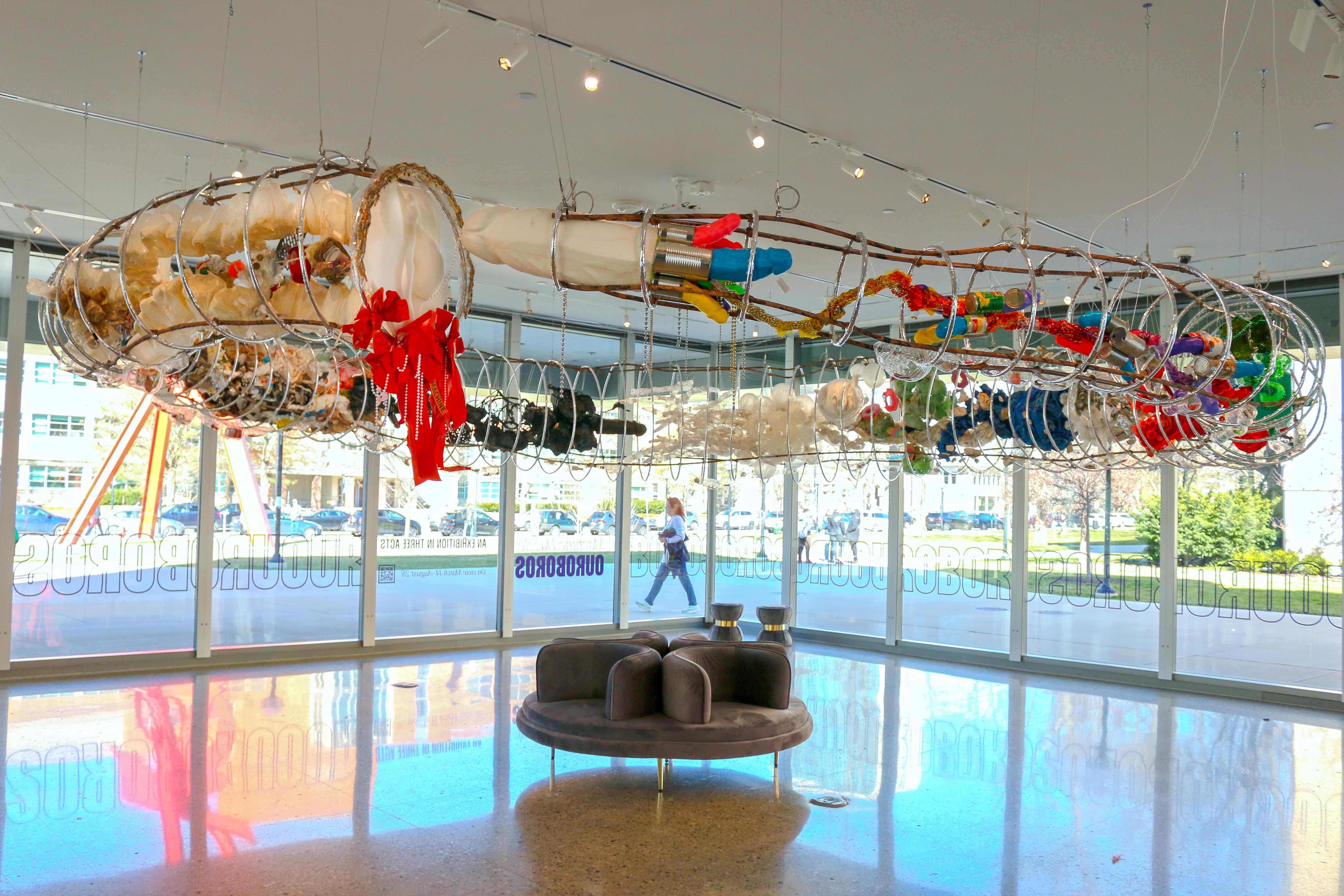
During the public viewing of the first phase of Ouroboros in March, the UMMA deputy director of public experience and learning, Jim Leija, gave opening remarks that reflected on just how long the idea of bringing Machine’s work to the museum had been percolating. Back in 2016, Leija said, he met Machine across campus in the basement of the Lydia Mendelssohn Theatre, where Machine was making what Leija described as “a human-sized macrame bikini type thing,” an experience he, as an onlooker, said was “wild, wonderful and joyful.” That garment was being made for performing artist Taylor Mac’s Pulitzer Prize-nominated “A 24-Decade History Of Popular Music,” which recently found a streaming home at HBO, where you can see Machine’s visionary costume work, made again from found objects and acquired materials, that meticulously interprets the time period from 1776 to 2016 in ways that are nothing short of fabulous. His “24-Decade” costumes represented pivotal moments in American and world history: the Vietnam War, the Summer of Love and the first man on the moon. “My work with Taylor is by far my most significant work that I’ve ever done,” Machine tells me.
For Leija, he couldn’t forget that week in 2016, which led up to the “24-Decade” performance and then to Ouroboros. “For me personally, I never forgot that week of watching Machine work and his incredible spirit, creativity and craftsmanship, and his amazing, mischievous sense of humor,” Leija said in his remarks. “I had always hoped that we would work together again, and being able to do this project together has truly been such a special privilege and a dream come true. To be in Machine’s universe is to be in a universe governed by endless possibilities, where ‘more is more’ is the law of the land, and where larger than life is just the right size.” Looking at Machine that night, he added, “You inspire us all to be bigger, better versions of ourselves, and see the fabulous in everything.”
Ouroboros will likely be the most stunning trash receptacle at a museum you’ve ever set your eyes on, where old junk is radiantly revived as if to say, during this precarious election year when so much is at stake for the queer community, we are capable of transformational beauty.
Somehow, seeing everyday garbage that very well could’ve been mine morphed into sculpture is weirdly reassuring in a way that is life-affirming; it tells me that nearly everything we are looking at now, be it the instant coffee container on Machine’s studio floor or the bans on gender-affirming healthcare for trans youth that seem never-ending in our modern era, is ephemeral. The effects on kids and climate change may be horrifying in this moment and in the future too, but even political and social change has similar malleable properties as a Sprite bottle that now looks like a gorgeous piece of blown glass. With Ouroboros, there’s hope in all of Machine’s dazzle — that the past may be the past, but something old can always be made into something new.

